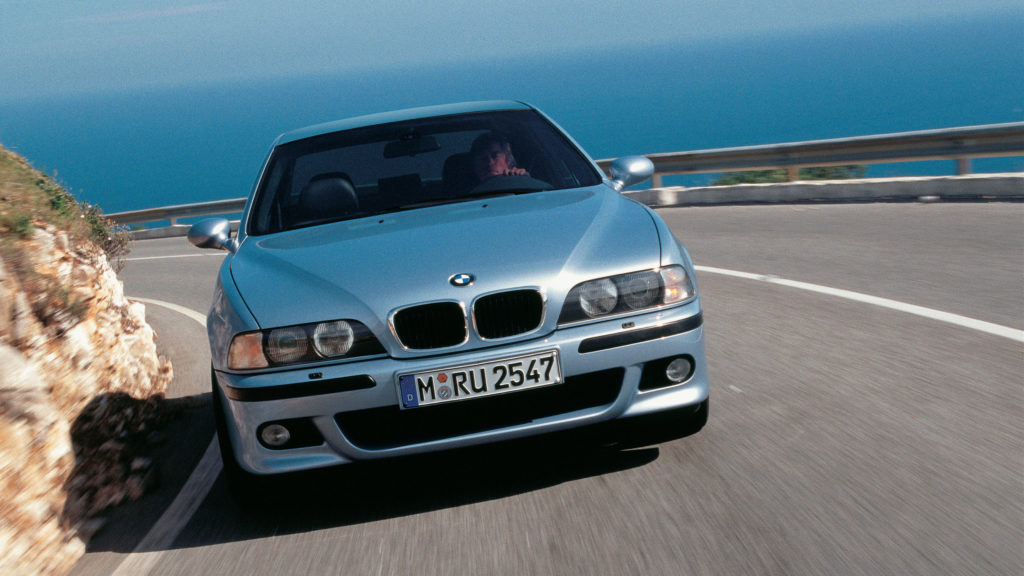When I was growing up, my family went on frequent camping trips, first in a small single-axle trailer made of corrugated metal, and then in a much larger RV made of fiberglass and wood. Thirty years earlier, when my father, my aunt, and their parents (my grandparents) were hitting the road and exploring the great American West, they stayed in teardrop trailers with gas-powered interior lighting, towed by full-size American cars with hitches quite literally bolted to their metal bumpers.
My dad with his uncle on the left behind my grandfather’s Mercury Monterey (equipped with the retractable rear “breezeway” window) and a family friend and business partner on the right with his Imperial Crown Southampton—note the Flitesweep trunk lid.
Of course, these were the days of ignition points, leaded gasoline, carburetors, bias-ply tires, and drum brakes. Yes, the bumpers, dashboards, and trim were all made of metal; and yes, we often look back at mid-20th-Century design and manufacturing through rose-tinted glasses—but were things really made better then, or built to last?
Hardly. Those with knowledge of the era, whether experiential or second-hand, will also recall the 90-day warranty—a mainstay of the Ford Model T era that lasted until the 1960s. They remember vehicles quickly becoming essentially worthless in the unending onslaught of newer, better-looking, and more capable models arriving every year. Prior to the 1980s, and really the 1990s, 100,000-mile engine rebuilds were common (lest we forget, odometers only recorded five digits).
Today, the modern automobile is likely to have fewer problems throughout its life. It will be driven faster and farther while using less fuel, it will require less in the way of maintenance, and it will offer more than ever in the form of creature comforts, technology, and safety equipment.
Ever since Korean automakers Kia and Hyundai introduced the 100,000-mile, ten-year warranty, other marques have followed suit, which stands as a testament to the confidence they have in the car of today lasting in a world where average drivers seem to know less than ever before about the machines they own and operate.
But what about after that warranty expires, and the market has long since moved on? We live in a disposable society, and you don’t have to look any further than the “lifetime-fill” fluid in the automatic transmission of your BMW, or the single-use bolts in the engine bay, to know the answer. These days it’s not just the bumpers and trim that are plastic, but also the cam and valve covers, oil and transmission pans, and more. It’s high-temperature plastic designed specifically for its purpose, but after experiencing warping of components on both the top of the engine and bottom of a transmission, I have to wonder just how close we’ve come to making a vehicle too disposable. (The exception is batteries, of course, but that’s a topic of discussion for another article.)
If I had to pick an era in which automotive quality—or, perhaps more accurately, automotive longevity—peaked, I’d choose approximately fifteen to twenty years ago, when BMW was building some of its most compelling models. At the same time, automakers were also selling some of their best-driving vehicles, which has consequently contributed to the relative scarcity of such cars today.
But don’t listen to my rambling; let the used-car market speak for itself. As my esteemed colleague David Rose explained a few weeks ago in his farewell to affordable BMW roadsters, the market has seen a substantial re-evaluation of things over the past eighteen months, and interest in cars from the 1980s and up seems like it’s never been higher. More specifically, cars from the late 1990s through the mid-2000s are also riding the wave, and these so-called modern classics are reaching new all-time highs—and for good reason.
BMW still has the word motor in its name, and even the mildly obsessed among us have no trouble rattling off engine designations, from M20 and M30 to S62 and S54. BMW is still making exceptional engines from V12 to inline four, but when we talk about the brand’s Golden Age, there were no turbochargers or direct fuel injection to speak of. Reliability was a point of contention in those days as well, but the subsequent decades have shown that these cars last as long as you want to drive them with proper maintenance. And that point is really the crux of it, because as electric power steering has taken the place of hydraulic, and as electric motors find their way into drivetrains, it seems that more and more of us have come to the conclusion that the cars of yesteryear may have actually been more fun to drive—and thus worthy of keeping far longer, which is something that’s happening with all used cars right now.
Some may cite interior build quality as a complaint from that era, and although things certainly look far more intricate today, whether or not they’re actually improved remains up for debate. It’s all too easy to get distracted by the latest and greatest, with cutting-edge technology and the best performance, while overlooking the sweet spot of balance that most of us once took for granted.
That’s how a car becomes a modern classic.
Plastic timing chain guides, anyone?
Acceleration times, horsepower figures, and new technology will likely always excite us, but emotional experiences stick with us; perhaps that’s why some of us have never quite gotten over the E46 M3 and E39 M5—and why the market hasn’t, either.
Some of us also are still waiting for the inevitable replacement—or spiritual successor—to arrive, but in a world in which the turbocharger is not only integrated with the exhaust manifold, but also the cylinder head itself, I wonder just how long we’ll actually be driving what’s new today, and whether there was one car that maybe we let go of a bit too soon.—Alex Tock
[Photos courtesy BMW AG.]
